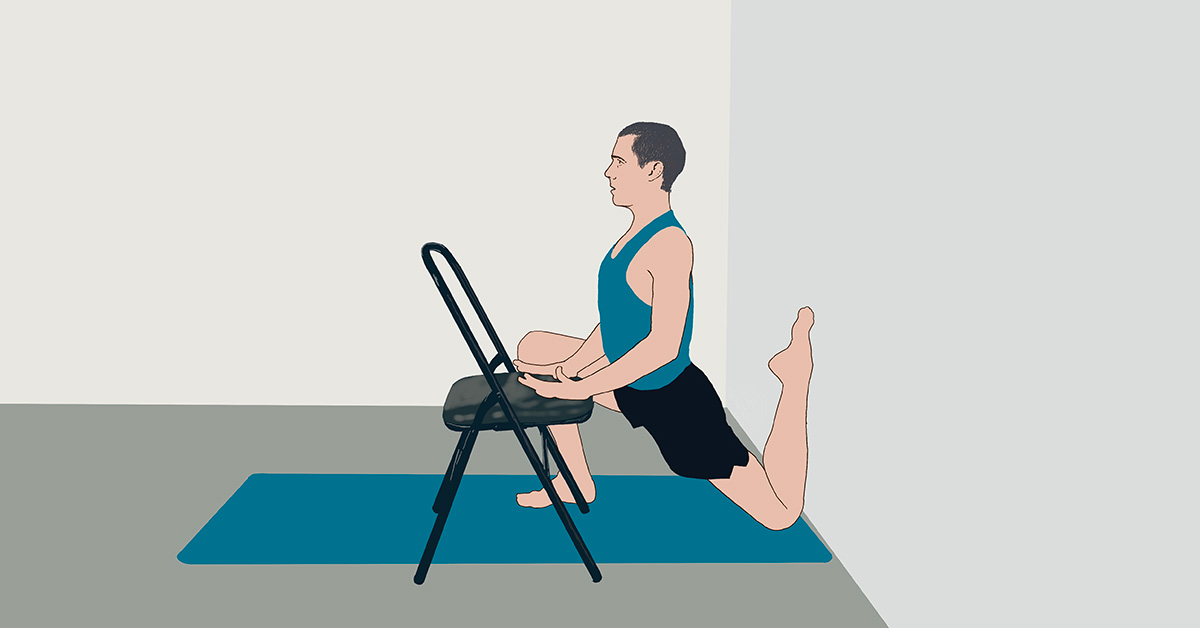A 40-minute Iyengar Yoga sequence to target the psoas with practical wall – and chair-based variations. Follow the step-by-step free video with accompanying photos to improve psoas mobility and ease common hip-flexor tightness. This psoas release yoga class is suitable for beginners and experienced students seeking better hip comfort, steadier posture, and relief after long periods of sitting.
Table of Contents
- About the Psoas
- Watch the Free Psoas Release Class
- Sequence Overview: 9-Pose Progression
- Virabhadrasana I (Warrior I) – Variation for Psoas
- Virabhadrasana I (Warrior I) – Elevating Front Foot
- Warrior I to Pidgeon Pose
- Eka Pada Rajakapotasana Variation with Chair
- Eka Pada Rajakapotasana with Shin to Wall
- Supta Virasana: Single Leg Variation
- Supta Virasana
- Eka Pada Rajakapotasana Variation
- Eka Pada Rajakapotasana Variaion for Psoas
- FAQs
About the Psoas
This 40-minute class is dedicated to yoga poses that lengthen and release the psoas muscle. The psoas is one of the primary hip flexors, located deep within the body, linking the lumbar spine to the inner thigh at the femur. It plays a key role in flexing the hip, stabilising the spine, and lifting the leg toward the torso. In modern life, long hours of sitting at desks or computers often cause the psoas to become shortened and tight. This can contribute to lower back pain, hip discomfort, and postural imbalances, and may limit access to deeper yoga poses, particularly backbends. The sequence begins with variations of Virabhadrasana I (Warrior Pose I), which are progressively adapted to target and lengthen the psoas. The practice then builds toward variations of Eka Pada Rajakapotasana (One-Legged King Pigeon Pose), which not only stretch the psoas but also address the broader hip flexor group and quadriceps. This class is ideal for anyone experiencing psoas-related issues, or for practitioners aiming to improve mobility in this vital area and expand their capacity for more advanced asanas.
Watch the free Psoas Release Class

Explore Yoga for the Psoas with Yoga Selection
Your membership gives you full access to every course and class — including psoas & hip-flexor sequences, the Yoga for Hips hub, the 30-Class Beginner Course, and our library of 900+ classes.
Start Free TrialNo commitment. Cancel anytime.
Psoas Release Yoga: 9-Pose Progression
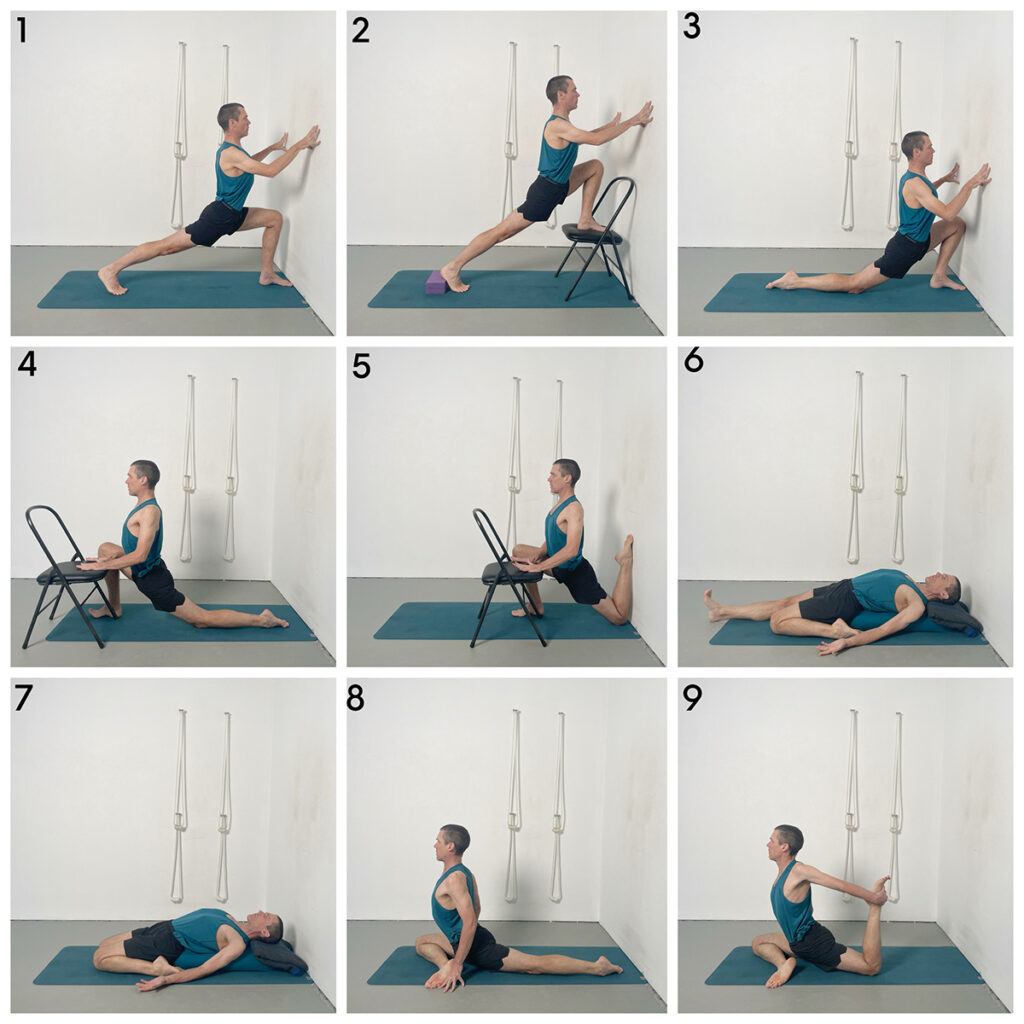
Use this grid as a quick map – Follow the detailed photos with step-by-step instructions below
Virabhadrasana I (Warrior I) – Variation for Psoas Release
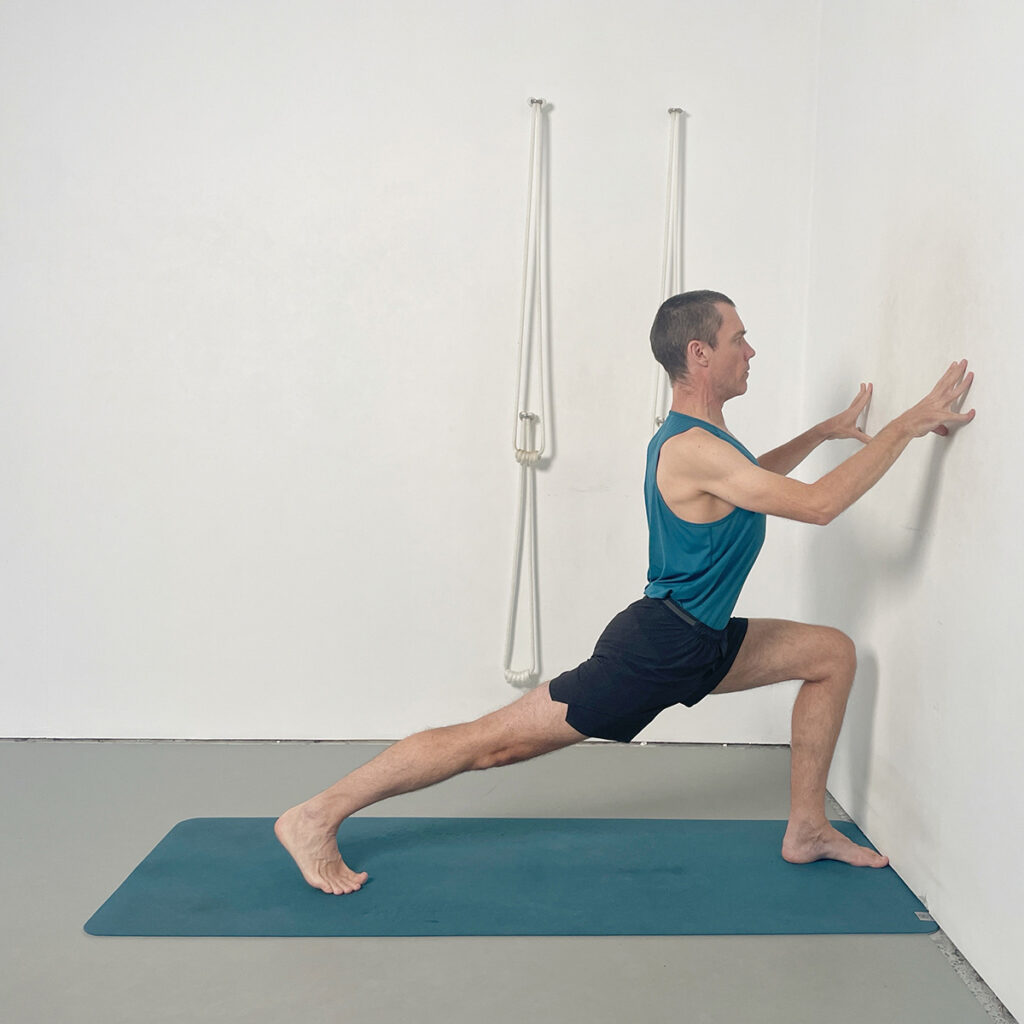
The class begins with a wall-supported version of Virabhadrasana I. This variation helps you clarify where the psoas is located in the body. It introduces simple and accessible actions that lengthen the psoas muscle. These basics techniques will be developed and taken further in the later poses.
- Stand facing the wall with the toes of your front foot front toes touching the wall. Place your fingertips to the wall at shoulder height. Step back with the other foot to establish a wide distance between the feet.
- Turn the pelvis to face directly ahead.
- Bend the front knee so the hips move forwards and downwards, while keeping the back knee straight – firm the kneecap and draw the back heel back and down.
- Move the back buttock in and let the back sitting bone tuck under so it points toward the floor; feel the opening gather at the front of the back hip.
- With a light downward drag of the fingertips, lift the chest and the front of the pelvis while containing the lower ribs – do not let the back knee bend.
Virabhadrasana I (Warrior I) – Elevating Front Foot
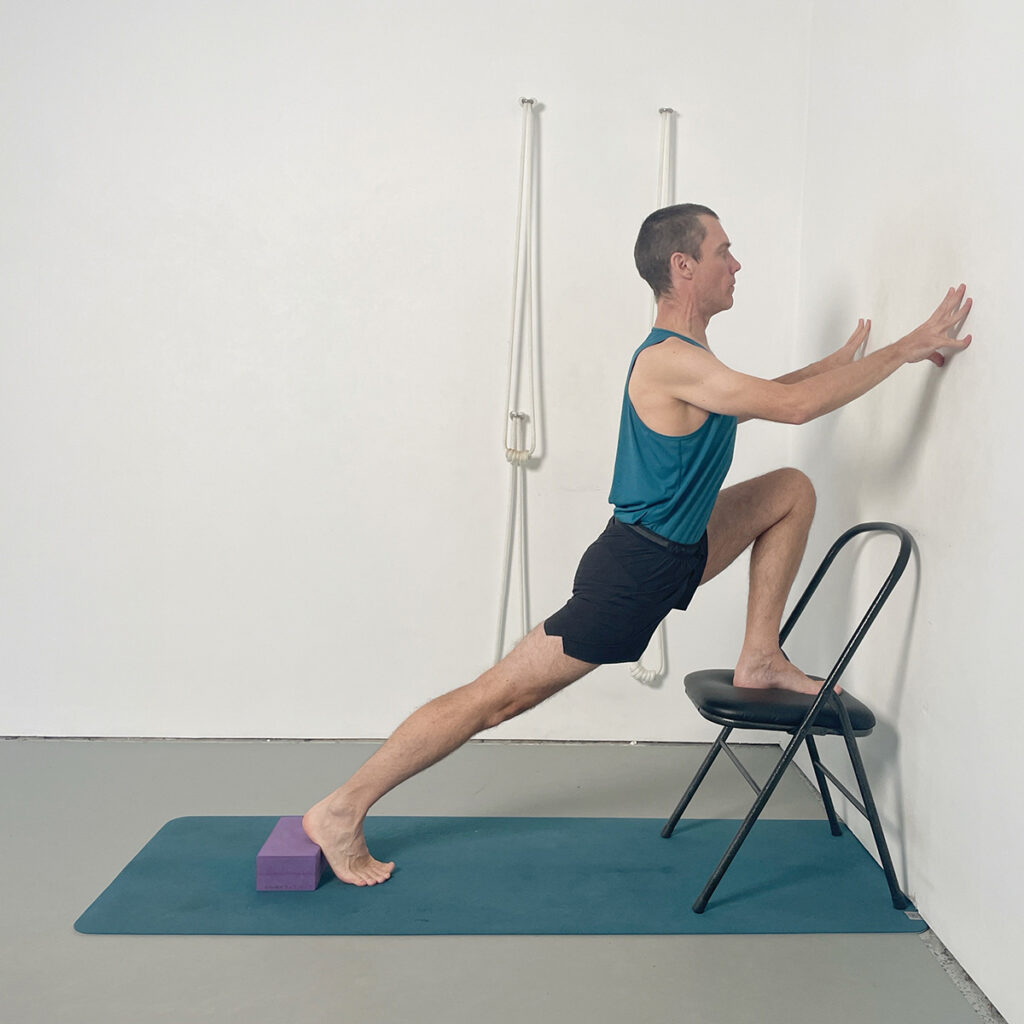
Elevating the front foot on a chair – and pressing the back heel into a block – brings the psoas more clearly into focus and highlights the hip-flexor action associated with the back leg in Virabhadrasana I.
- Place the back of the chair against the wall; put a yoga block on the mat where your back heel will be positioned.
- With fingertips on the wall at shoulder height, step the front foot to the seat of the chair seat; bring the back heel onto the block.
- Lunge your hips forwards and downwards so the front knee sits directly over the ankle. If the knee pushes past the ankle, move the block back and take more distance.
- Straighten the back knee; press the back heel down into the block and move the back buttock in, keeping the pelvis facing directly ahead.
- Maintain back knee straight / heel pressing onto the block. Use a light downward drag of the fingertips against thewall to lift the chest and front pelvis, and keep the outer back hip turning forwards.
Warrior I to Pidgeon Pose
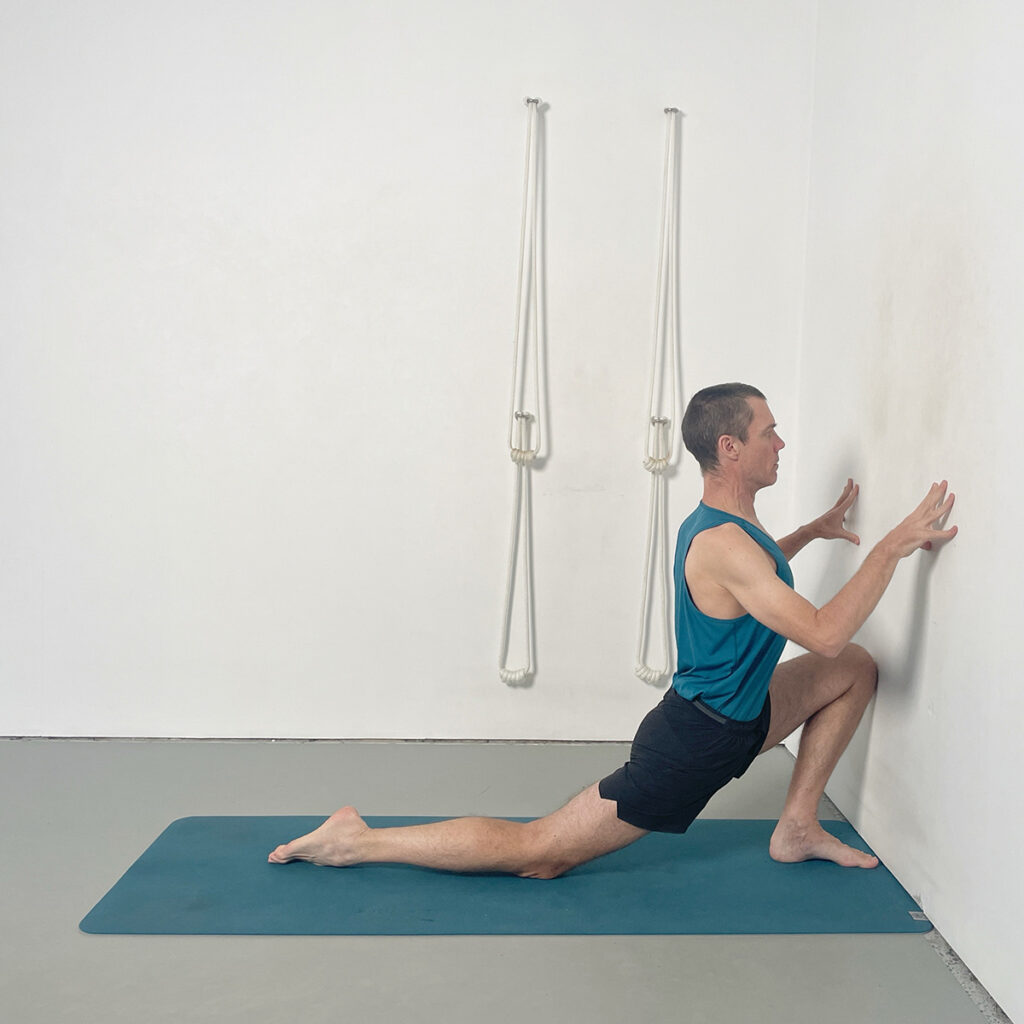
This variation develops the Virabhadrasana I actions in the direction of Eka Pada Rajakapotasana. Bringing the back knee to the floor introduces a deeper lunge that begins to lengthen the quadriceps as well as the psoas, creating a clear, focused opening at the front of the back hip.
- If needed, place a blanket under the back knee for cushioning. Set up with front toes to the wall; step the back foot back, then bend the front knee and lower the back knee to the floor. Bring the top of the back foot down with toes pointing back.
- Place fingertips on the wall at shoulder height.
- Allow the front knee to move toward the wall; let the shin angle forward – you’re not trying to keep the knee above the ankle here. Keep the front heel grounded.
- Release the front quadriceps progressively: soften near the knee, then the mid-thigh, and into the groin crease so the pelvis can sink forwards and down.
- Lift the chest and the front of the pelvis; you may feel the back knee lightly drag the mat forward as the chest rises.
- Turn the outer hip of the back leg forward.
Eka Pada Rajakapotasana Variation with Chair
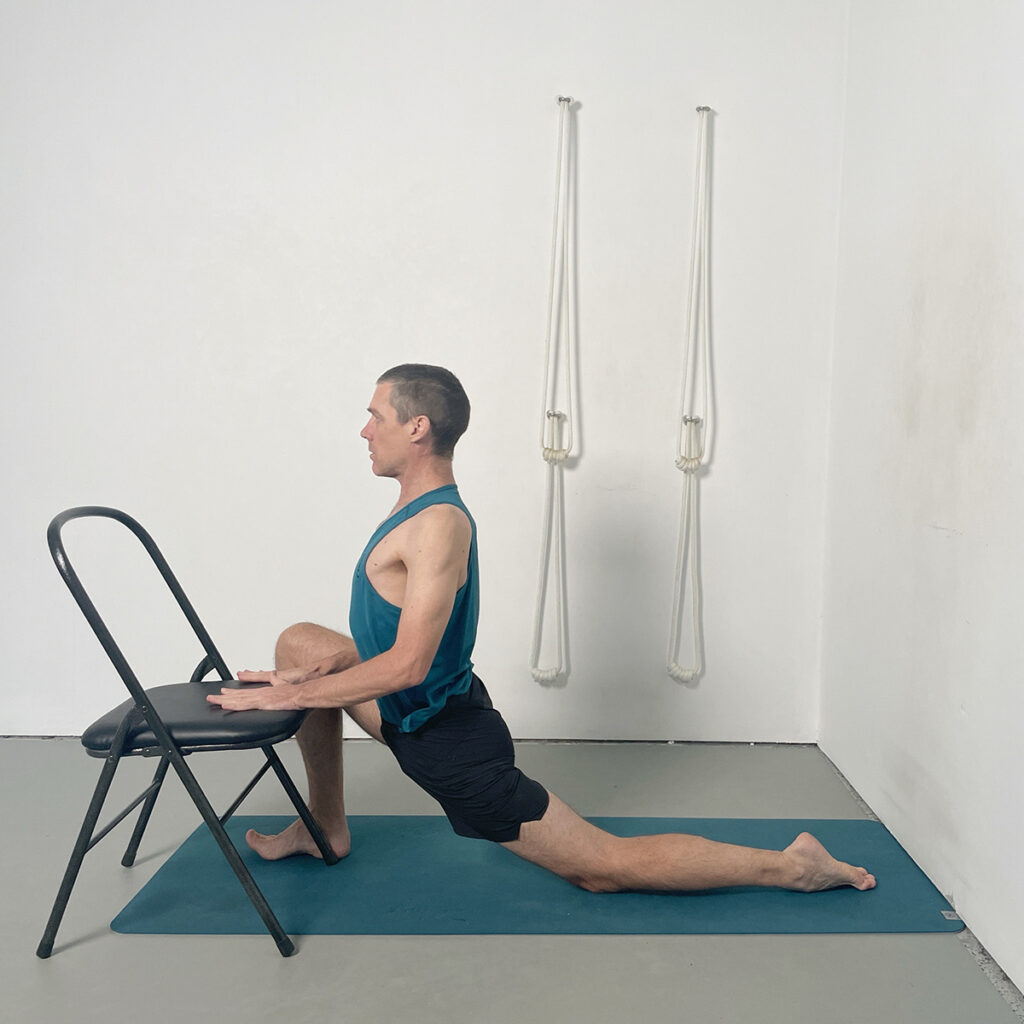
Replacing the wall with a yoga chair develops the same psoas lengtheing actions whilst giving you greater support and control. With your hands on the seat you can support more of your body weight with your arms and gain more freedom to lunge the pelvis forwards and downwards.
- Step the feet out ready for Virabhadrasana I.
- If practicing on a hard floor surface you may need to place a flat blanket under the back knee.
- Position the chair beside the inner heel of the front foot, lunge forwards with both hands on the seat bringing the back knee to the floor.
- Keep your shoulders over the hips.
- As your hips descend allow the front knee to move forward while keeping the front heel grounded.
- Release the front quadriceps in stages—near the knee → mid-thigh → groin crease—so the pelvis can progressively descend.
- Press the hands to lift the chest and front pelvis.
Eka Pada Rajakapotasana with Shin to Wall
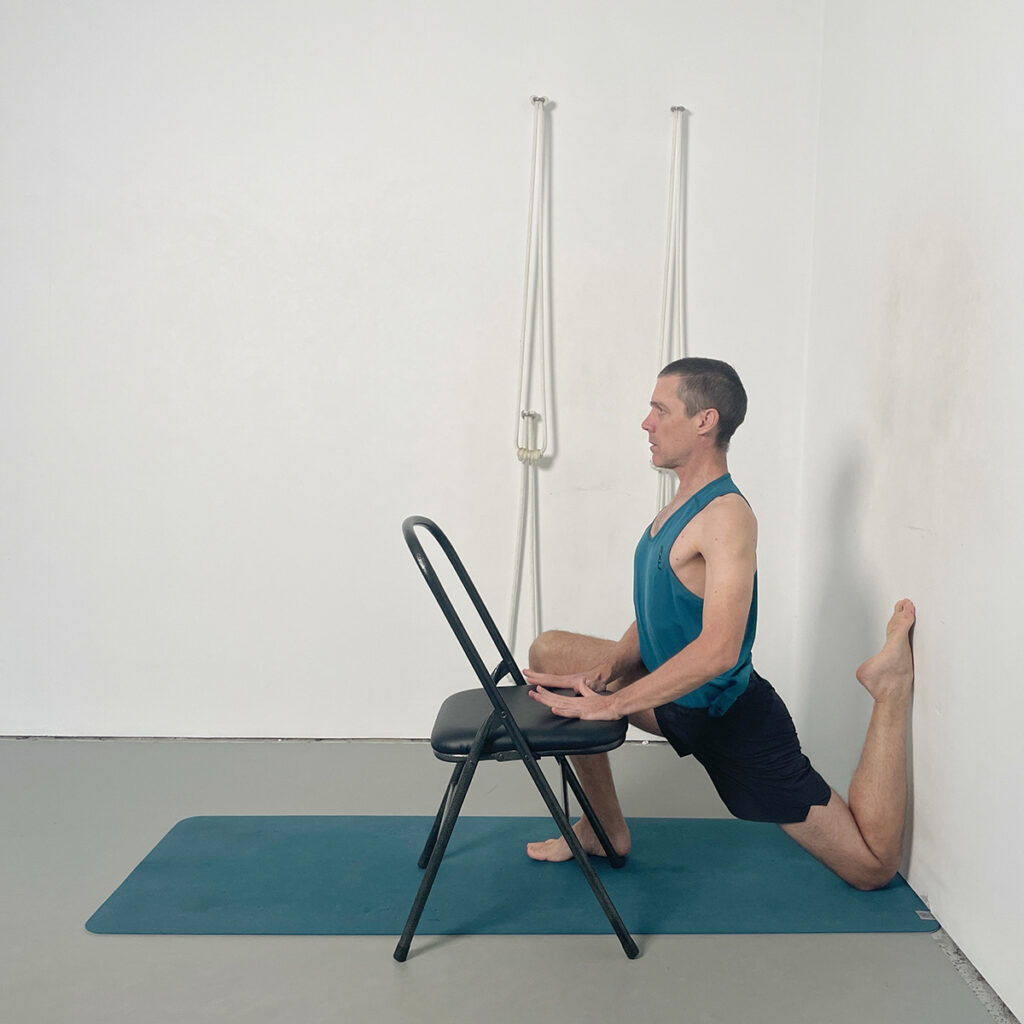
Continuing further in the direction of Eka Pada Rajakapotasana, bend the back leg placing the shin up the wall. This adjustment will intensify the focus on both the hip flexor and quadriceps muscle groups. The chair offers incremental control as you come in and out of the variation.
- Place a blanket at the base of the wall for the back knee. Move the chair close to the wall, seat facing you; slide it so the foot of the chair sits between your knees when you set up.
- From kneeling with your hands on the seat of the chair, slide the back knee to the wall and take the shin up the wall; choose either knee right to the wall (more intense) or leave a small gap (less intense).
- Place the sole of the front foot to the floor beside the chair.Bring the front inner heel beside the foot of the chair. Place both hands on the seat; elbows lightly bent so the arms can organise the pose while the shoulders stay back over the hips.
- Lunge forwards keeping the shoulders over the hips and the front heel grounded.
- Tuck the back sitting bone under and turn the outer back hip forward to keep the pelvis facing the chair.
Supta Virasana: Single Leg Variation
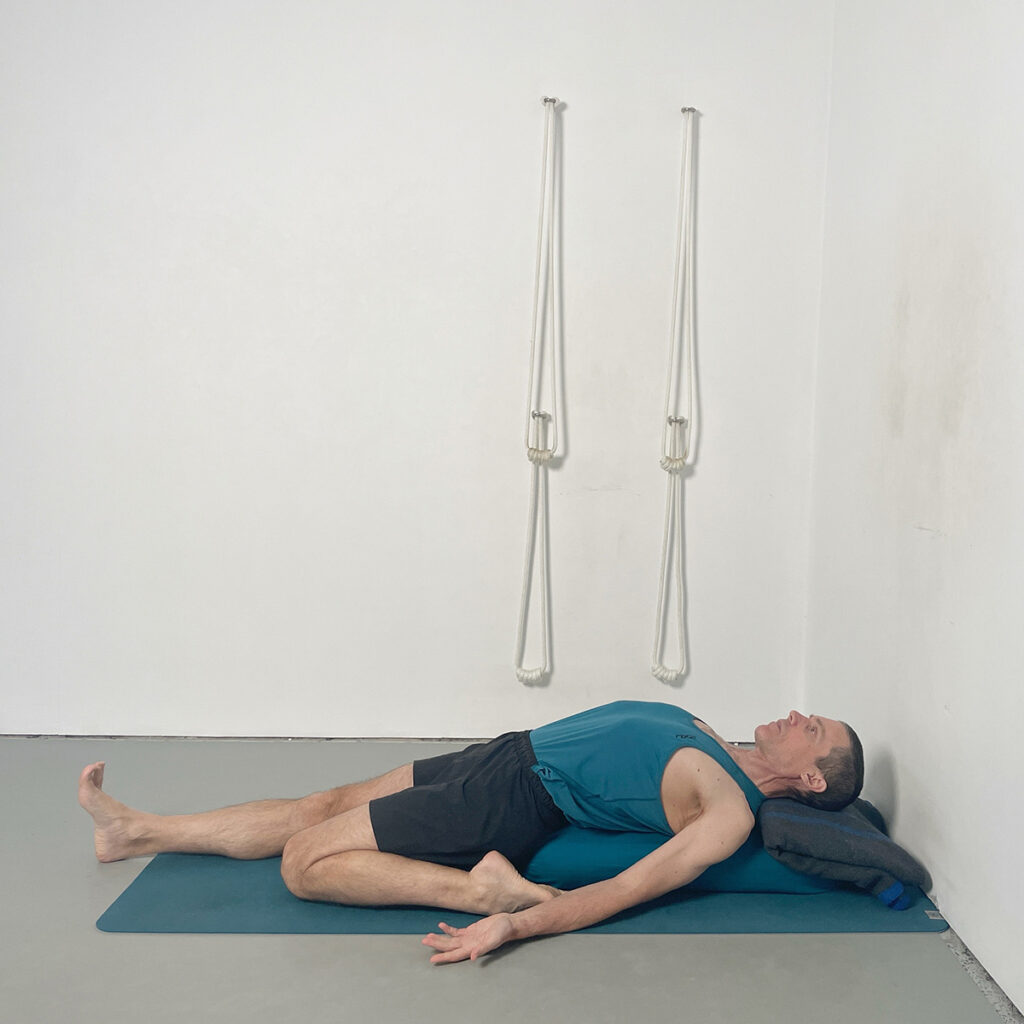
The class now transitions from Eka Pada Rajakapotasana toward Supta Virasana variations. In this version you recline over a bolster with one leg in Virasana and the other straight, alternating sides. This targets the quadriceps and hip-flexor line while gently working knee flexion in a supported position.
- Place a lengthwise bolster and block behind you; add a half-fold blanket for the head/neck. Sit on the block with your back to the bolster.
- Right side first: lean left, bend the right knee back, and move the right calf muscle out to the side; sit upright again with toes pointing back.
- Recline with control: lower the left elbow, then the right elbow, and lie back so the head rests on the blanket; arms out by the sides, palms up.
- Keep the right heel bone facing directly upwards.
- Lengthen the outer right knee move toward the centre, this gently brings the right knee closer to the left, then settle the head of the shin bone down toward the floor.
Supta Virasana
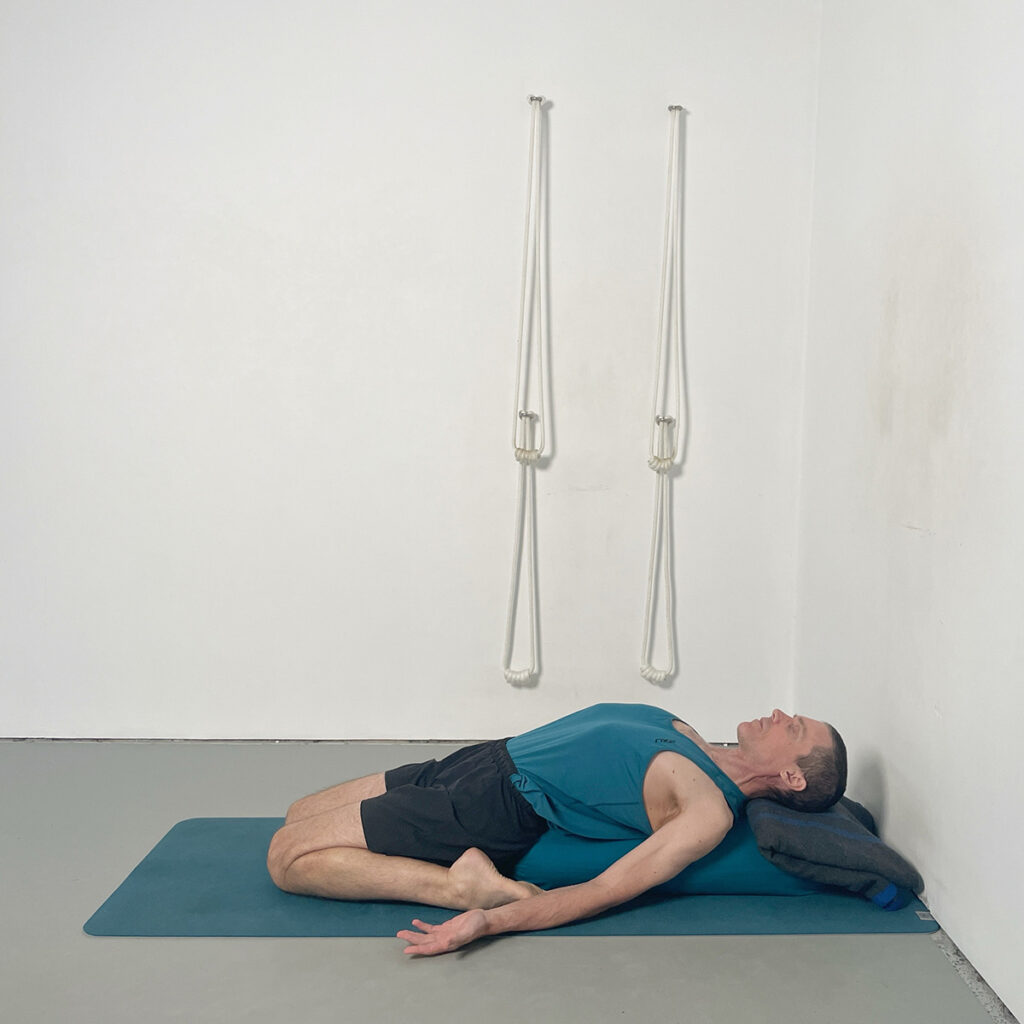
After consolidating Supta Virasana one leg at a time, you can now progress to the two-legged version. In addition to being therapeutic for the knees, quadriceps and hip flexors, this asana is commonly used as a starting posture for a yoga sequence.
- Place two three-fold blankets end-to-end and position a lengthwise bolster on top; add a folded head blanket. Kneel with knees together and ankles either side of the folded blanket where the hips will sit.
- With both hands on the calves, draw the calf flesh back and out to the sides as you lower your pelvis onto the blanket.
- Lie back bringing first the elbows to the floor, then the torso onto the bolster and finally the head onto the folded blanket; arms relaxed by the sides.
- Then refine: gently squeeze the inner heels away from the hips; let the outer knee creases move toward the centre so the knees come together over time. Finally, press the heads of the shin bones down while keeping the tailbone tucked and the chest lifted.
Eka Pada Rajakapotasana Variation
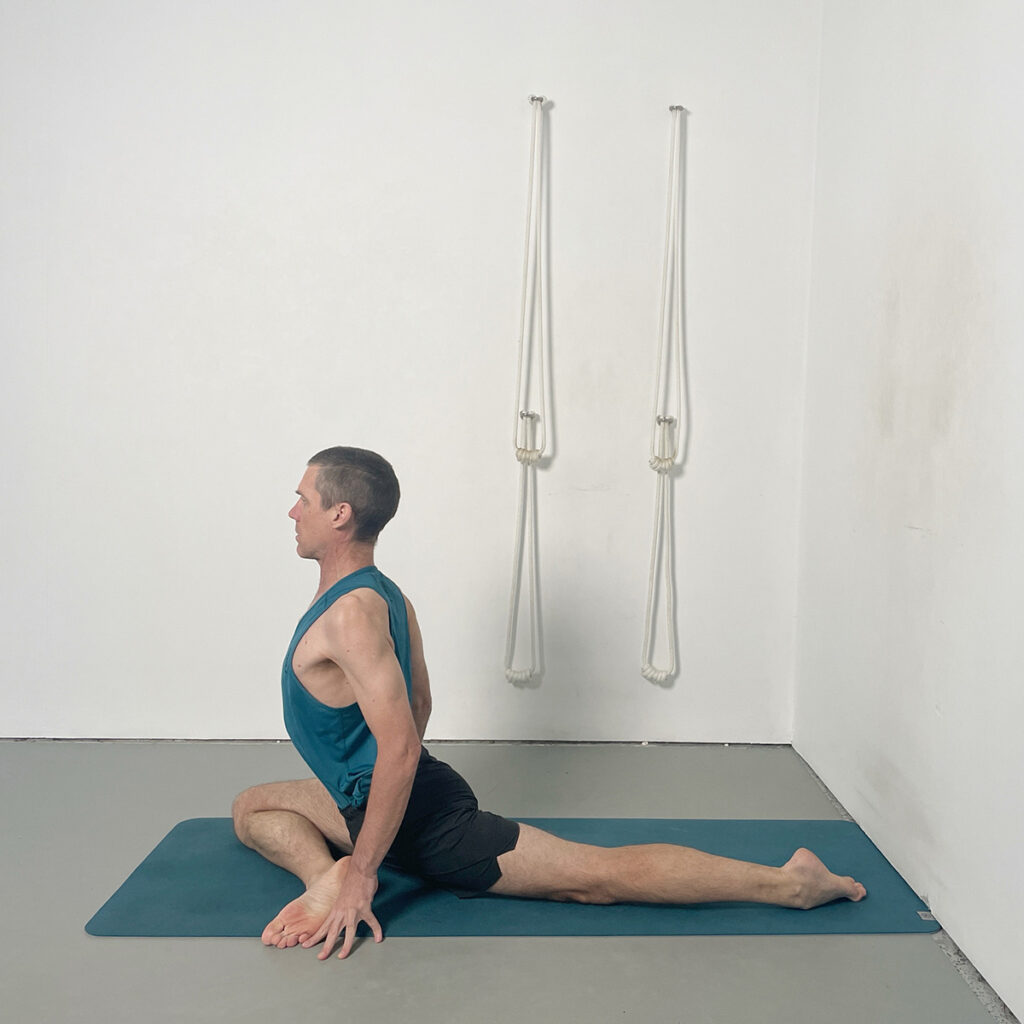
The class now returns to Eka Pada Rajakapotasana variations. While this pose naturally opens the gluteals of the front leg, here the emphasis is on the psoas/hip-flexor region of the back leg. Prioritise keeping the torso upright, with hands beside the pelvis and shoulders over the hips, so the opening gathers at the front of the back hip.
- From Downward Facing Dog Pose, bring the front knee forward, placing the shin on a 45° angle and the knee slightly wider than the hip.
- Place hands on the floor beside the pelvis and let the hips descend. Soften the front knee and buttock – so the front hip socket can descend.
- If the back hip sits higher, slide a folded blanket under the front sitting bone to level the pelvis.
- Lift the chest and roll the shoulders back.
- On the back leg, keep the centre of the foot to the floor and turn the outer hip forwards.
Eka Pada Rajakapotasana Variaion for Psoas Release
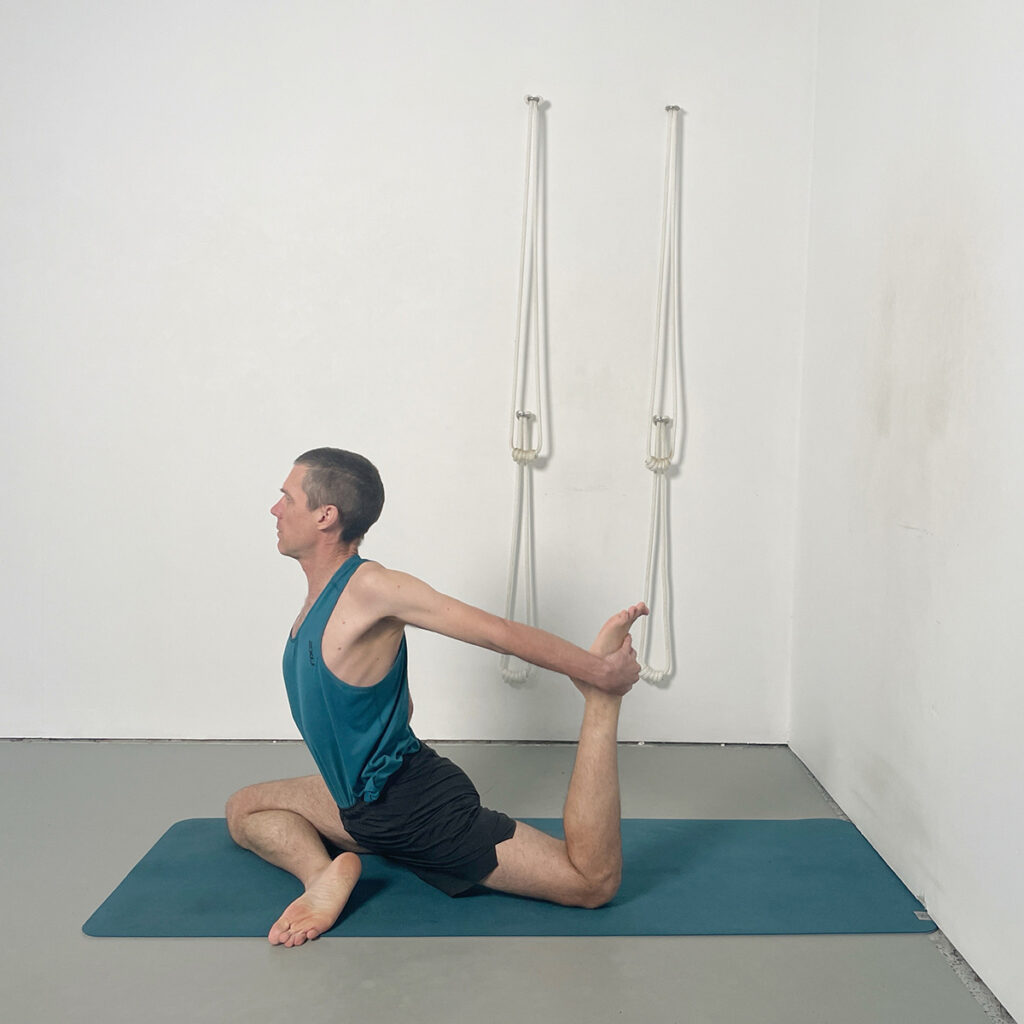
The class culminates by bending the back knee and reaching back to hold the ankle. This preparatory action can eventually lead toward the classical Eka Pada Rajakapotasana backbend and brings the psoas-quadriceps connection into clear focus. Many of the concepts and actions from the sequence come together here so depth can develop progressively.
- From Stage 8, begin to bend the back knee, then reach back with the back-hand and hold the ankle from the outer side (thumb pointing down the leg). Use a belt if you can’t reach comfortably.
- Release the front buttock, letting the front hip socket descend; if needed, keep a folded blanket under the front hip for support.
- Let the back knee rest to the floor.
- Lift the chest and roll the shoulders back; turn the outer back hip forward so the pelvis faces the front. Avoid leaning to the side.
- To deepen the pose if desired, bend the elbow to bring the heel closer to the torso, keeping the chest lifting.
FAQs
Q. Where should I feel this?
A. At the front of the back hip and along the front thigh of the back leg. If you feel pinching or strain, reduce range and return to the previous support.
Q. I can’t reach my back foot in pigeon—any tips?
A. Use a belt around the ankle and keep the trunk upright. If needed, place a blanket under the front hip to level the pelvis.
Q. Will this help if I sit a lot or feel tight after running/cycling?
A. Yes – the sequence is designed to lengthen the hip-flexor line and ease front-hip gripping that often follows long sitting or repetitive leg work.
Q. How do I know if I’m focusing the psoas rather than just the quads?
A. Keep the back knee straight when indicated, draw the heel back and down, and turn the outer back hip forward. The sensation gathers at the front of the back hip, not just the middle of the thigh.
Q. Is this safe if my lower back can be sensitive?
A. Favour the supported options (wall, chair, padding). Keep the trunk upright, contain the ribs, and reduce range before form changes. If symptoms persist, consult a health professional.

Explore Yoga for the Psoas with Yoga Selection
Your membership gives you full access to every course and class — including psoas & hip-flexor sequences, the Yoga for Hips hub, the 30-Class Beginner Course, and our library of 900+ classes.
Start Free TrialNo commitment. Cancel anytime.
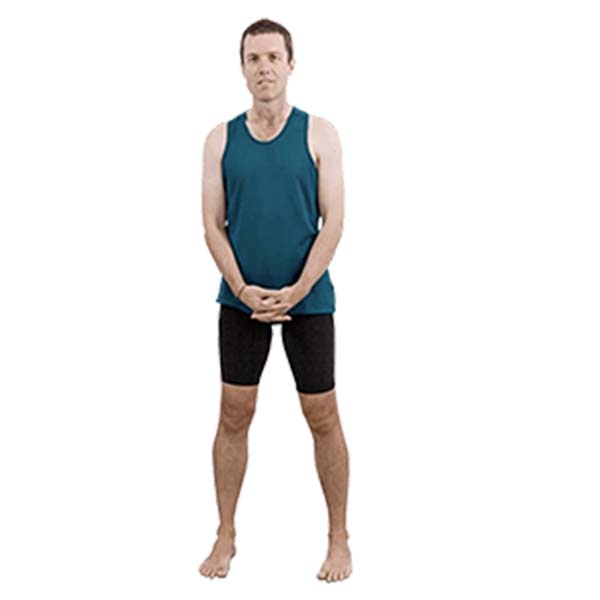
Rod Stennard – Founder of Yoga Selection
Rod Stennard is the founder of Yoga Selection, the first online yoga platform dedicated entirely to Iyengar Yoga. A certified Iyengar Yoga teacher since 2002, Rod has practiced yoga since 1992 and studied under senior teachers from around the world, including members of the Iyengar family in Pune, India.
Rod launched Yoga Selection in 2016 to bring structured, high-quality Iyengar Yoga training to a global audience. As a pioneer in the field of online yoga education, he is passionate about making this method accessible to all, through rigorous, inclusive, and thoughtfully designed classes. His work continues to support students of all levels in over 50 countries.
Explore More Psoas Related Sequences:
Yoga for Hips – 10 Part Online Course
Yoga For Hip Flexors – 4 Part Online Course
Iyengar Yoga Forward Bends: a Comprehensive Online Guide
